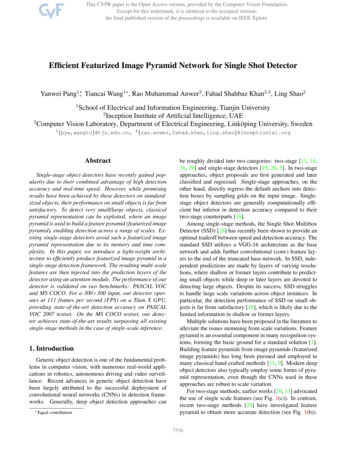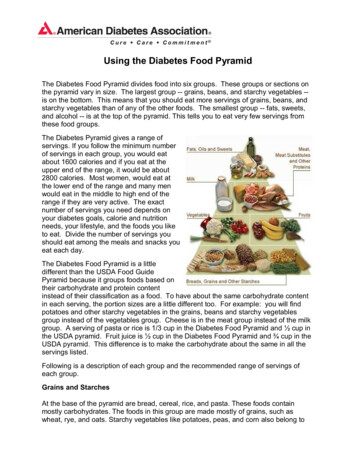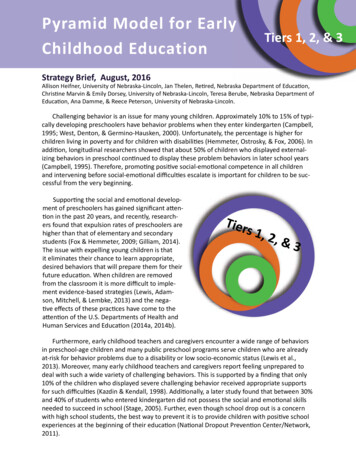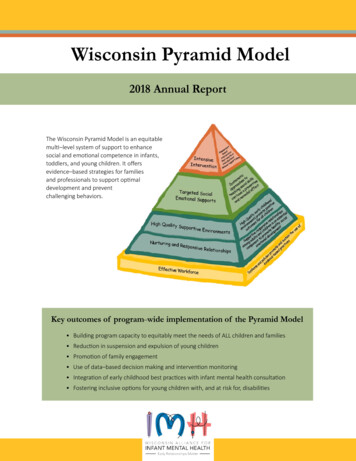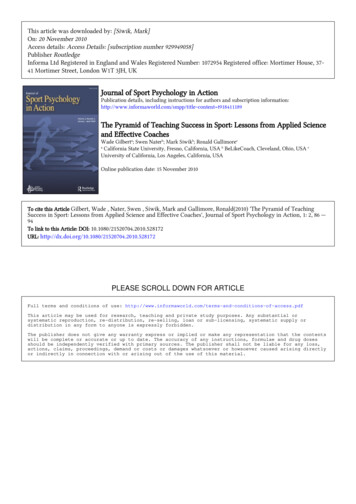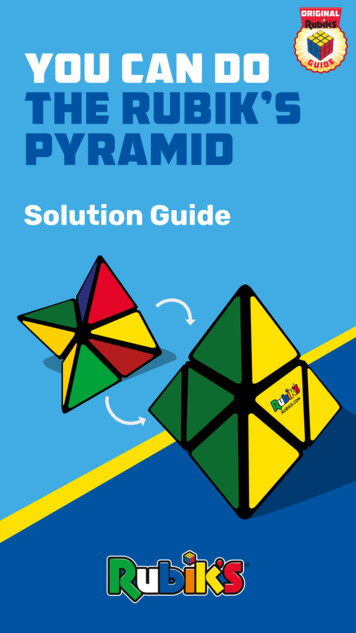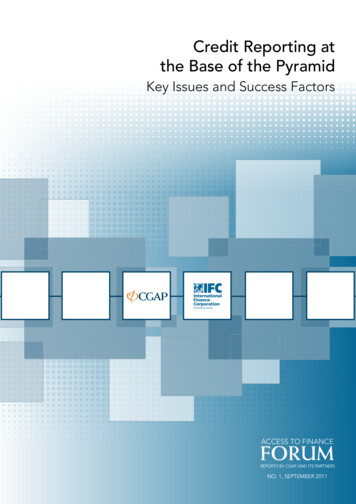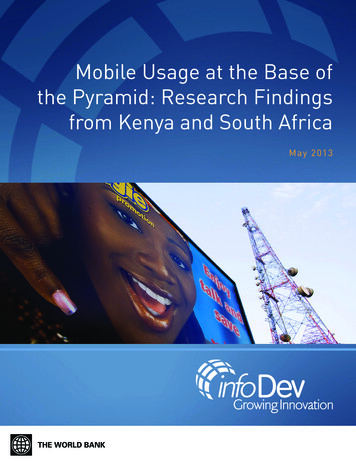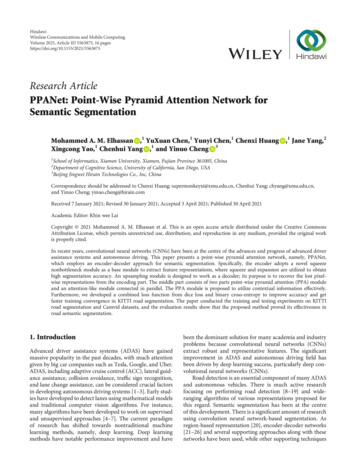
Transcription
HindawiWireless Communications and Mobile ComputingVolume 2021, Article ID 5563875, 16 pageshttps://doi.org/10.1155/2021/5563875Research ArticlePPANet: Point-Wise Pyramid Attention Network forSemantic SegmentationMohammed A. M. Elhassan ,1 YuXuan Chen,1 Yunyi Chen,1 Chenxi Huang ,1 Jane Yang,2Xingcong Yao,1 Chenhui Yang ,1 and Yinuo Cheng 31School of Informatics, Xiamen University, Xiamen, Fujian Province 361005, ChinaDepartment of Cognitive Science, University of California, San Diego, USA3Beijing Jingwei Hirain Technologies Co., Inc, China2Correspondence should be addressed to Chenxi Huang; supermonkeyxi@xmu.edu.cn, Chenhui Yang; chyang@xmu.edu.cn,and Yinuo Cheng; yinuo.cheng@hirain.comReceived 7 January 2021; Revised 30 January 2021; Accepted 3 April 2021; Published 30 April 2021Academic Editor: Khin wee LaiCopyright 2021 Mohammed A. M. Elhassan et al. This is an open access article distributed under the Creative CommonsAttribution License, which permits unrestricted use, distribution, and reproduction in any medium, provided the original workis properly cited.In recent years, convolutional neural networks (CNNs) have been at the centre of the advances and progress of advanced driverassistance systems and autonomous driving. This paper presents a point-wise pyramid attention network, namely, PPANet,which employs an encoder-decoder approach for semantic segmentation. Specifically, the encoder adopts a novel squeezenonbottleneck module as a base module to extract feature representations, where squeeze and expansion are utilized to obtainhigh segmentation accuracy. An upsampling module is designed to work as a decoder; its purpose is to recover the lost pixelwise representations from the encoding part. The middle part consists of two parts point-wise pyramid attention (PPA) moduleand an attention-like module connected in parallel. The PPA module is proposed to utilize contextual information effectively.Furthermore, we developed a combined loss function from dice loss and binary cross-entropy to improve accuracy and getfaster training convergence in KITTI road segmentation. The paper conducted the training and testing experiments on KITTIroad segmentation and Camvid datasets, and the evaluation results show that the proposed method proved its effectiveness inroad semantic segmentation.1. IntroductionAdvanced driver assistance systems (ADAS) have gainedmassive popularity in the past decades, with much attentiongiven by big car companies such as Tesla, Google, and Uber.ADAS, including adaptive cruise control (ACC), lateral guidance assistance, collision avoidance, traffic sign recognition,and lane change assistance, can be considered crucial factorsin developing autonomous driving systems [1–3]. Early studies have developed to detect lanes using mathematical modelsand traditional computer vision algorithms. For instance,many algorithms have been developed to work on supervisedand unsupervised approaches [4–7]. The current paradigmof research has shifted towards nontraditional machinelearning methods, namely, deep learning. Deep learningmethods have notable performance improvement and havebeen the dominant solution for many academia and industryproblems because convolutional neural networks (CNNs)extract robust and representative features. The significantimprovement in ADAS and autonomous driving field hasbeen driven by deep learning success, particularly deep convolutional neural networks (CNNs).Road detection is an essential component of many ADASand autonomous vehicles. There is much active researchfocusing on performing road detection [8–19] and wideranging algorithms of various representations proposed forthis regard. Semantic segmentation has been at the centreof this development. There is a significant amount of researchusing convolution neural network-based segmentation. Asregion-based representation [20], encoder-decoder networks[21–26] and several supporting approaches along with thesenetworks have been used, while other supporting techniques
2Wireless Communications and Mobile ComputingInputOutputSignalReLU1x1 Conv3x3 DWConvderEncoA3x3 DWConvStride 21x1 ConvPPA moduleUpBDecCoderClassifierUpsample unitElement-wise multiplicationElement-wise additionPoint-wise pyramid attention moduleUpsampleC3x3 ConvS-nbt unit3x3 Conv3x3 ConvLow-level featuresHigh-level featuresFigure 1: Overall architecture of the proposed PPANet. The encoder adopts squeeze-nbt in an FCN-like network, while PPA and anupsampling unit were employed in the decoder.fused 3D LiDAR point cloud with 2D images, such as [27,28]. In this paper, we focus on road segmentation usingRGB images. Inspired by the seminal segmentation modelU-Net [29], inception [30], SqueezeNet [31], and deep residual learning [32], we propose an architecture that takes thestrengths of these well-established models and performssemantic segmentation more effectively. The proposed newarchitecture is named PPANet (point-wise pyramid attentionnetwork), which follows the encoder-decoder approach. Insummary, our main contributions could be summarized asfollows.Firstly, we introduce a novel module named point-wisepyramid attention (PPA module) to acquire long-termdependency and multiscale features without much computation burden. Secondly, we design an upsampling module tohelp to recover the lost details in the encoder. Thirdly, basedon the possibility for improvement, we propose a squeezenbt module to extract feature representations in the encoder.At last, we combine these modules in an encoder-decodermanner to construct our PPANet for semantic segmentation.The designed model was used to improve the performance ofroad understanding on KITTI road segmentation and Camvid datasets.2. Related Works2.1. Encoder-Decoder Method. In semantic segmentation, themain objective is to assign a categorical label to every pixel inan image, which plays a significant role in road scene understanding. The success and advances in deep convolutionalneural network (CNN) models [30, 32–34] have a remarkable impact on pixel-wise semantic segmentation progressdue to the rich hierarchical features [29, 35–38]. Usually, toobtain a more delicate result from such a deep network, itis essential to retain high-level semantic information whenusing low-level details. However, training such a deep neural network requires a large amount of data, but only alimited number of training examples are available in manypractical cases. One way to overcome this problem is byemploying transfer learning through a network that is pretrained on a big dataset then fine-tuned on the targeted dataset,as done in [36, 39]. Another solution for such a problem is performing extensive data augmentation, as done in U-Net [29]. Inaddition to data augmentation, the model architecture shouldbe designed to propagate the information from low levels tothe corresponding high levels in a much easier way, such asU-Net.2.2. Deep Neural Networks. Since the seminal AlexNet [33],model architecture with only eight layers, many studies havebeen proposed with new approaches for a classification task.Later on, these developed models were applied successfully toa different computer vision task, for example, to segmentation [36], object detection [34], video classification [40, 41],object tracking [42], human pose estimation [43], and superresolution [44]. These successes spurred the design of a newmodel with a very large number of layers. However, thesegrowing numbers of layers will need tedious hyperparametertuning, and that can increase the difficulty of designing suchkind of model. In 2014, VGGNet [34] was proposed, in whicha significant improvement has been made by utilizing a widerand deeper network; their approach introduced a simple yeteffective strategy for designing a very deep network. Thequality of a deeper network has a significant impact onimproving other computer vision tasks. ResNet [32] hascome with an even very deeper model. However, increasingthe depth of the network could cause a vanishing gradientproblem [32]. Many techniques have been introduced to
Wireless Communications and Mobile Computing31x1 Conv1x1 Conv1x1 ConvTotal 5paths1x1 Conv3x3DWConv1x1 ConvAdd3x3DWConv1x1 ConvAdd3x3 DWConvFire moduleConcatenateConcatenateFigure 2: Squeeze-nbt module.prevent vanishing gradients, for instance, using an initialization method MSR [45] and batch normalization [46].Meanwhile, skip connection (identity mapping) was usedto ease the training process of deep networks without vanishing gradient problems, although VGGNet has a simple architecture, which requires high computation capabilities. On theother hand, inception model families have been designed toperform well with constraint memory and low computationbudget. In an Inception module, a split transform-mergestrategy where the input feature maps are split into lowerdimensions (using 1 1 convolutions) then transformed bya combination of specialized filters (7 7, 5 5, and 3 3)and merged in the end by concatenating branches is adopted.2.3. Semantic Segmentation with CNN. Recent segmentationbased methods have a significant contribution to solvingmany computer vision problems, using a wide range of techniques such as a Fully Convolutional Network (FCN) [36],FCN with conditional random field CFD [46], region-basedrepresentation [20], encoder-decoder networks [21–23],and multidimensional recurrent networks [47]. Furthermore,pyramid pooling and its variance have a great impact on therecent advances in semantic segmentation [48–53].2.4. Dilated Convolution-Based Architecture. Dilated convolution or atrous convolutions [53] are a powerful tool in therecent progress of semantic segmentation [52]. It is used toenlarge the receptive field while maintaining the same number of parameters. Recently, many approaches focus on multimodal fusion and contextual information aggregation toimprove semantic segmentations [52, 54, 55]. ParseNet [56]applies average pooling to the full image to capture the globalcontextual information. Spatial pyramid pooling (SPP) [57]has inspired the use of pyramid pooling to aggregate multiscale contextual information such as pyramid pooling [51]module and atrous spatial pyramid pooling module (ASPP)[53, 58]. DenseASPP [59] is proposed to generate dense connections to acquire a larger receptive field. To empower theTable 1: The PPANet network architecture.InputStageTypeStrideOutput size160 600 3Stage 1Squeeze-nbt unitSqueeze-nbt unit2180 300 3280 300 32Stage 2Squeeze-nbt unitSqueeze-nbt unit2140 150 6440 150 64Stage 3Squeeze-nbt unitSqueeze-nbt unit2120 75 12820 75 128Stage 4Squeeze-nbt unitSqueeze-nbt unit2110 75 25610 75 256CentrePPA moduleDec 1Upsampling unit—20 75 128Dec 2Upsampling unit—40 150 64Dec 3Upsampling unit—80 300 32Final1 1 Conv1160 600 CEncoderDecoder20 75 128ASPP module, Xie et al. [60] introduced vortex pooling toutilize contextual information.3. Methodology3.1. Architecture. In this work, we proposed a point-wise pyramid attention network (PPANet) for semantic segmentation, as shown in Figure 1. The network is constructed withan encoder-decoder framework. The encoder is similar tothe classification networks; it extracts features and encodesthe input data into compact representations. At the sametime, the decoder is used to recover the corresponding representations. The squeeze-nbt unit in Figure 2 is used as themain building block for the different stages in the encoderpart. Each stage in the encoder has two blocks of thesqueeze-nbt unit and the feature map downsampled by halfat each first block in each stage using stride convolution
4Wireless Communications and Mobile ComputingAveragepool 3x31x1 Conv1x1 Conv1x1 ConvAveragepool 3x3SigmoidC3x3 DWConvrate: 3UpOutputAveragepool 6x6Input featuremap3x3 DWConvrate: 61x1 ConvAveragepool 9x93x3 DWConvrate: 9Figure 3: Point-wise pyramid attention module.(for more details, see Table 1. The network has two otherparts: the point-wise pyramid attention module and attention module inserted between the encoder and the decoder.These modules in the centre have been used to enrich thereceptive field and provide sufficient context information.More details will be discussed in the following sections.3.2. Basic Building Unit. This subsection elaborates thesqueeze-nbt module architecture (as illustrated in Figure 2).It draws its inspiration from several concepts that have beenintroduced into recent state-of-the-art models in classification and segmentation, such as the fire module in SqueezeNet[31], depthwise separable convolution [61], and dilated convolution [58]. Figure 2 is the squeeze-nbt module andencoder-decoder framework. We introduce a new modulenamed squeeze-nbt (squeeze nonbottleneck) module. It isbased on a reduce-split-squeeze-merge strategy. Thesqueeze-nbt module first uses point-wise convolution toreduce the feature maps and then apply a parallel fire moduleto learn useful representations. To make squeeze-nbt computationally efficient, we adopted 3 3 dilated depthwise separable convolution instead of computationally expensive3 3 convolution.3.3. Upsampling Module. Several methods such as [21–23,62], transpose convolution [63], or bilinear upsampling havebeen utilized broadly to gradually upsample encoded featuremaps. In this work, we proposed the upsample module towork as a decoder and to refine the encoded feature mapsby aggregating features of different resolutions. First, thelow-level feature is processed with 3 3 convolution and inparallel the high-level features upsampled to match the features coming from the encoder; these different features areconcatenated and refined with two consecutive 3 3convolutions.3.4. Point-Wise Pyramid Attention (PPA) Module. Segmentation requires both sizeable receptive field and rich spatialinformation. We proposed the point-wise pyramid attention(PPA) module, which is effective for aggregating global contextual information. As shown in Figure 3, the PPA moduleconsists of two parts: the nonlocal part and vortex pooling.On the one hand, the nonlocal module will generate densepixel-wise weight and extract long-range dependency. Onthe other hand, vortex atrous convolution is useful in detecting an object at multiple scales. By analysing the vortex pooling and nonlocal dependency, we fuse these two modules’advantages in one module named the point-wise pyramidattention (PPA) module. The PPA module consisted of threeparallel vortex atrous convolution blocks with dilation ratesof 3, 6, and 9 and one nonatrous convolution block.The point-wise pyramid attention module is shown inFigure 3. Let X be the input feature map where X RH W Cand W, H, and C are width, height, and channels, respectively. First, we apply two parallel convolution layers F 1 RH W C and F 2 RH W C to generate a feature map of F a RH W C ′ , where C ′ C/4 indicates the number of channelsof F a :F 1 conv1 1ðX Þ,F 2 conv1 1ðX Þ:ð1ÞThen, we calculate the similarity matrix S RHW HW ofF 1 and F 1 by a matrix multiplication F s F 1 F T2 .Lastly, softmax is applied to normalize the result andtransform F s to self-attention-like mechanism:Output Softmaxð F s Þ:ð2Þ4. Experimental Results and AnalysisIn this section, comprehensive experiments on the KITTIroad segmentation dataset [64] and Camvid dataset [65] arecarried out. We evaluate the efficiency and effectiveness of
Wireless Communications and Mobile Computing5(a) Without mathematical morphology(b) With mathematical morphologyFigure 4: Comparison between PPANet (a) without mathematical morphology and (b) with mathematical morphology. In the first picture,some pixels belong to nonroad classified as a road.Table 2: Ablation study results on the KITTI dataset.AP (%) Precision (%) Recall max FMethodPPANet-baselinePPANet, r 3, 6, 13PPANet, r 2, 4, 8PPANet, r 2DecoderPPANet upsampling unitPPANet 94.3395.4893.0195.16Table 3: Comparison of our model with other networks on theKITTI road segmentation dataset, using average precision (AP),precision, recall, and F-measure.MethodSegNet [23]ENet [21]FastFCN [68]LBN-AA [66]DABNet [67]AGLNet [69]Ours (PPANet)AP (%)Pre (%)Rec (%)max 095.6090.1088.2095.3095.0094.1096.3096.30our proposed architecture. Firstly, an introduction to thedatasets and the implementation protocols is given. We thenelaborate on the loss function and the evaluation metricsused to train KITTI, followed by ablation studies and exper-iments with the SOTA models. Finally, we report a comparison on the Camvid dataset.4.1. Datasets and Implementation Details4.1.1. Datasets(1) KITTI Road Segmentation Dataset. It consists of 289training images with their corresponding ground truth. Thedata in this benchmark is divided into 3 categories: urbanmarked (UM) with 95 frames, urban multiple marked lane(UMM) with 96 frames, and urban unmarked (UU). Thedataset has a small number of frames and difficult lightningconditions, which make it very challenging. In total, it has290 frames for testing (testing frames have no ground truthinformation). Training and testing frames were extractedfrom the KITTI dataset [64] at a minimum spatial distanceof 20 m. Each image has a resolution of 375 1242. We splitthe dataset into three subsets: (a) training samples with 173images, (b) validation samples with 58 images, and (c) testingsamples with 58 images.(2) Camvid Dataset. The Camvid dataset is an urban streetscene understanding dataset in autonomous driving. It consists of 701 samples: 376 training samples, 101 validationsamples, and 233 test samples, with 11 semantic categoriessuch as building, road, sky, and bicycle, while class 12 contains unlabelled data that we ignore during training. Theoriginal image resolution for the Camvid dataset is 960 720. It has been downsampled into 360x before training fora fair comparison. A weighted categorical cross-entropy loss
6Wireless Communications and Mobile Computing(a)(b)(c)(d)Figure 5: Examples of road detection images for the UM test set obtained from the public benchmark suite in perspective view. (a, c) Show thesegmentation results; (b, d) show the original images.
Wireless Communications and Mobile Computing7(a)(b)(c)(d)Figure 6: Examples of road detection images for the UMM test set obtained from the public benchmark suite in perspective view. (a, c) Showthe segmentation results; (b, d) show the original images.
8Wireless Communications and Mobile Computing(a)(b)(c)(d)Figure 7: Examples of road detection images for the UU test set obtained from the public benchmark suite in perspective view. (a, c) Show thesegmentation results; (b, d) show the original images.
Wireless Communications and Mobile Computing9Table 4: Results of the model on the Camvid dataset.The binary cross-entropy:MethodYearParams (M)mIoU (%)Deeplab-LFOV [58]PSPNet [51]DenseDecoder [73]SegNet [23]ENet [21]BiSeNet2 [70]CGNet [71]NDNet45-FCN8-LF [72]LBN-AA [66]DABNet [67]AGLNet [69]PPANet 669.170.955.661.368.764.057.568.066.469.470.10was used to compensate for a small number of categories inthe dataset.4.1.2. Implementation Details. All experiments were implemented with one GTX1080Ti CUDA 10.2 and cuDNN 8.0on Pytorch [58] deep learning framework. The Adam [59]optimizer is a stochastic-based optimizer used with an initiallearning rate of 4e 4 to train KITTI road segmentation andCamvid datasets. The learning rate is adjusted according toEquation (3), where α is the initial learning rate, F is a factorused to control the learning rate drop, D is the number ofepochs to decrease the learning rate value, and i is the currentepoch. In PPANet implementation, the learning rate isreduced by a factor of every 15 epochs. The proposed network is limited to run for a maximum of 300 epochs. Normalweight initialization [45] is used to initialize the model.Finally, 7e 3 of l2 regularization to deal with the modeloverfittingαi 1 α1 · F ð1 iÞ/D :ð3Þ(1) Loss Function. There is a wide range of loss functions proposed over the years to perform semantic segmentation tasks.For instance, binary cross-entropy (BCE) has been applied tomany research in classification and segmentation withremarkable success. Although it is convenient to train neuralnetworks using BCE, it might not perform well in classunbalance. For instance, it does not perform well when it isused as the only loss function on KITTI road segmentationwith PPANet. In this work, our total loss Equation (6) is acombination of dice loss Equation (5), which was proposedin Zhou et al. [62], and binary cross-entropy Equation (4).Let p ½0 1 be the prediction given by a sigmoid nonlinearityand let pˆ ½0 1 be the corresponding ground truth. Dice losshas been implemented in a different form in literature; forinstance, in [62, 63], it has equivalent definitions, differingin the denominator value. Our experiment found that usingthe dice loss function that uses the summation of squaredvalues of probabilities and ground truth in the denominatorperforms better. These functions are defined as follows.BCEðp, p̂Þ p log ̂p ð1 pÞ log ð1 p̂Þ:ð4ÞiDice loss:Di ðp, p̂Þ p pb i i i : i p2i p̂2ið5ÞTotal loss:losstotal BCEðp, p̂Þ Di ðp, p̂Þ:ð6Þ4.1.3. Evaluation Metrics on KITTI. Precision and recall evaluation metrics can be considered one of the most commonmetrics for evaluating a binary classification; following themethods used in [64, 66, 67], we evaluated our segmentationmodel using precision Equation (7), recall Equation (8), andF-measure Equation (11). The evaluation metrics are listedin the following equations:PRE ðprecisionÞ REC ðrecallÞ TP,TP TFTP,TP FNð7Þð8ÞPFR FP,TP FPð9ÞFNR FN,TP FNð10Þ2 PRE REC,PRE RECð11ÞTP TN:TP TN FP FNð12ÞF‐measure Accuracy 4.1.4. KITTI Data Augmentation. Data augmentation comprises a wide range of techniques used to extend the trainingsamples by applying random perturbations and jitters to theoriginal data. In our model, an online data augmentationapproach helps the model learn more robust features andincrease the generalizability by preventing the model fromseeing the same image twice, as slightly random modificationto the input data is performed each time. Therefore, we perform a series of data transformation to deal with typicalchanges in road images, such as texture and colour changesand illumination. In particular, we implemented normalization, blurring, and changing the illumination. Data augmentation can lend itself naturally in the context of computervision. For example, we can acquire additional training datafrom the original KITTI road segmentation images by applying the following transforms:(1) Transformation that applied to both image and theground truth
10Wireless Communications and Mobile ComputingTable 5: Per-class results on the Camvid test set in terms of class mIoU scores.MethodsSegNet [23]ENet [21]BiSeNet2 [70]CGNet [71]NDNet45-FCN8-LF [72]LBN-AA [66]DABNetAGLNet [69]PPANet (ours)BuiTreeSkyCarSigRoaPedFenPolSideBicmIoU 562.761.1255.651.368.764.757.568.065.769.470.1(i) Geometric transformations are used to alter theposition of the point, such as translation, scaling,and rotations(ii) Mirroring (horizontal flip)(2) Transformations that applied to the image only sincethey affect only pixel values(i) Normalize the input image by standardizingeach pixel to be in ½ 1, 1 range using Equation(13)(ii) Random brightness adjustment(iii) Gaussian blur(iv) Random noise:input 2 1:0255ð13Þ(1) Mathematical Morphology. Applying deep learningmethods to the segmentation of a road sometimes results insome noise. Nonroad could be classified as a road and viceversa. Several mathematical morphology techniques can beused to remove the noise and improve the performance ofthe model in the testing time. An opening mathematicalmorphology process with square structuring elements of 15 15 sizes was used. It helped the network eliminate someof the nonroad classified as a road (false positive), as illustrated in Figure 4, where (a) represents the performance ofthe model without augmentation, and we can see the noiseby the side of the road, and (b) shows the effect of removingthis false positive when training the model.4.2. Ablation Study4.2.1. Encoder. We carried out some ablation studies to highlight the effectiveness of our proposed model structure. Theproposed method baseline achieves 96.3% max F and 96.2%AP; then, we run experiments with different dilation rate settings. First, we gradually increased the dilation rates 3, 9, and13 in the encoder at stages 2, 3, and 4, respectively, whichresult in a decrease of 6.32% F-measure and 4.25% averageprecision. To further examine and verify the effectiveness ofour method with a range of dilation rates, we employedanother combination dilation rates, 2, 4, and 8, which yieldthe lowest result in the ablation experiments with 89.36% F-measure and 78.9%. This sequence of dilation rates hasgiven lower results. It seems that the combination of dilationrates is not effective for the PPANet encoder. Finally, wetested our model using a dilation rate of 2 in the three stagesof the encoder and yield the best outcome for our model, asshown in Table 2. Therefore, we set the dilation rate of 2for all three stages in the encoder.4.2.2. Decoder. We test two settings in the decoding part.First, using the upsampling unit comprises bilinear upsampling and convolution to restore the high-resolution featurefrom low-resolution features; this approach achieved goodresults. However, still, there is some information lost duringdownsampling the feature map in the encoding process. Tomaintain the highest possible global context feature, wedesigned a point-wise pyramid attention that is used toincrease the model prediction performance with both PPAand upsampling unit; the decoder can aggregate informationthrough a fusion of a multiscale feature. Therefore, it effectively captures local and global context features (see Table 2for further comparison). It can be seen that the proposedupsample unit and the point-wise pyramid attention (PPA)improve the segmentation-based PPANet and helped achievesuperior AP, precision, recall, and max F score compared toother models.4.3. Comparing with the SOTA. In this subsection, we willpresent the overall qualitative and quantitative assessmentof the trained model. The training and evaluation were conducted using the KITTI road segmentation and Camvid datasets. We then compare the model with a selected SOTAmodel. Table 3 shows the comparison of PPANet with otherSOTA models on the KITTI road segmentation dataset.PPANet is designed for road scene understanding, and it isbeing trained end-to-end. As previously stated, the datasethas a limited amount of data divided into three categories:urban unmarked (UM road), urban multiple marked lanes(UMM road), and urban unmarked (UU road) as one category to help alongside data augmentation to overcome modeloverfitting. To rank the best performance among the chosen
Wireless Communications and Mobile Computing11(a)(b)Figure 8: Continued.
12Wireless Communications and Mobile Computing(c)Figure 8: Visual results of our method PPANet on the Camvid test set: (a) is the image, (b) is the prediction, and (c) is ground truth.models for comparison and evaluation, we reported precision(PRE), recall (REC), and max F metrics, which are knownmetrics used to evaluate different approaches in binarysemantic segmentation. We have chosen some state-of-the-art models to perform a comparison with our proposed PPANet model. These models include SegNet [23], ENet [21],FastFCN [68], LBN-AA [66], DABNet [67], and AGLNet[69]. The overall results of PPANet and other SOTA models
Wireless Communications and Mobile Computingare illustrated in Figure 3. Our PPANet obtained the highestscores for all metrics, demonstrating the effectiveness of theproposed method for robust road detection; FastFCN rankedsecond in terms of precision and third for max F, while ALGNet has better f -measure. ENet achieved the lowest resultscompared to all other models. It is designed for speedpurposes.For qualitative performance evaluation of our model inroad segmentation, a visual representation of PPANet predictions in the KITTI dataset test set is presented inFigures 5–7 in perspective view for UM, UMM, and UU,respectively. We can see that the urban marked (Figure 5)road got the best prediction with almost no misclassification.For urban unmarked, there is little noisy prediction that canbe improved using some postprocess optimization techniques such CRF or increasing the amount of data. Whenwe move to the urban multiple unmarked, it has a highermisclassified road area; it has some area outside the road predicted as road. These false positive detections mainly occur inpole railway when it is close to the road, and also, the roaddetection is affected by shadow. So, our model with only3.01 M parameters and without pretrained weights got quiteexcellent results in a small dataset such as KITTI roadsegmentation.4.4. Comparison with SOTA Models on Camvid. In this subsection, we design an experiment to demonstrate our proposed network effectiveness and validity on the Camviddataset. We train and evaluate the model in the trainingand validation images and validation set for 400 epochs.Then, the model was
pyramid pooling and its variance have a great impact on the recent advances in semantic segmentation [48-53]. 2.4. Dilated Convolution-Based Architecture. Dilated convo-lution or atrous convolutions [53] are a powerful tool in the recent progress of semantic segmentation [52]. It is used to enlarge the receptive field while maintaining the .
